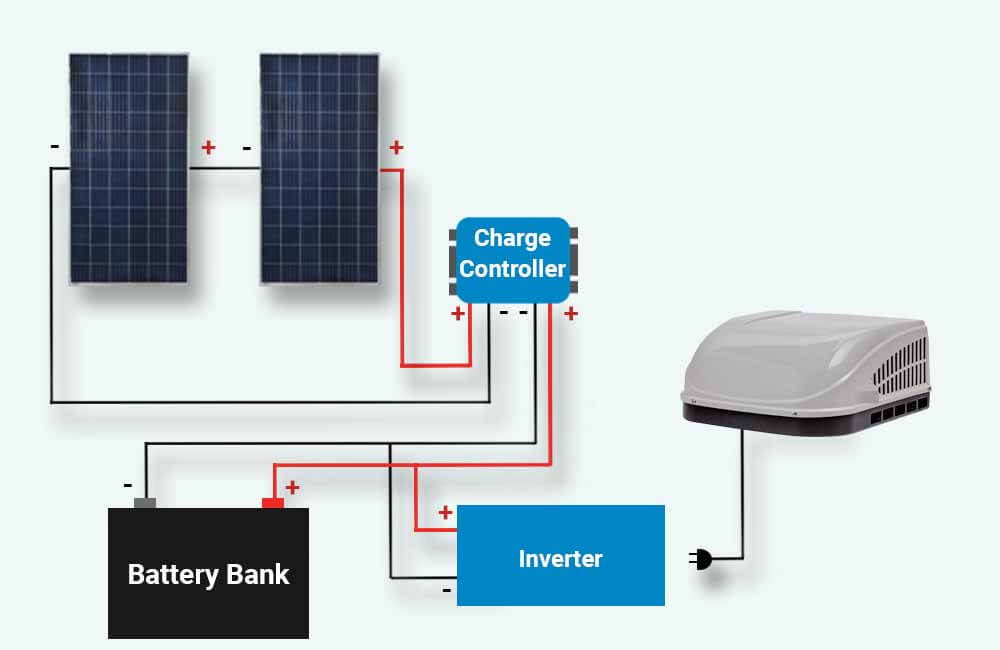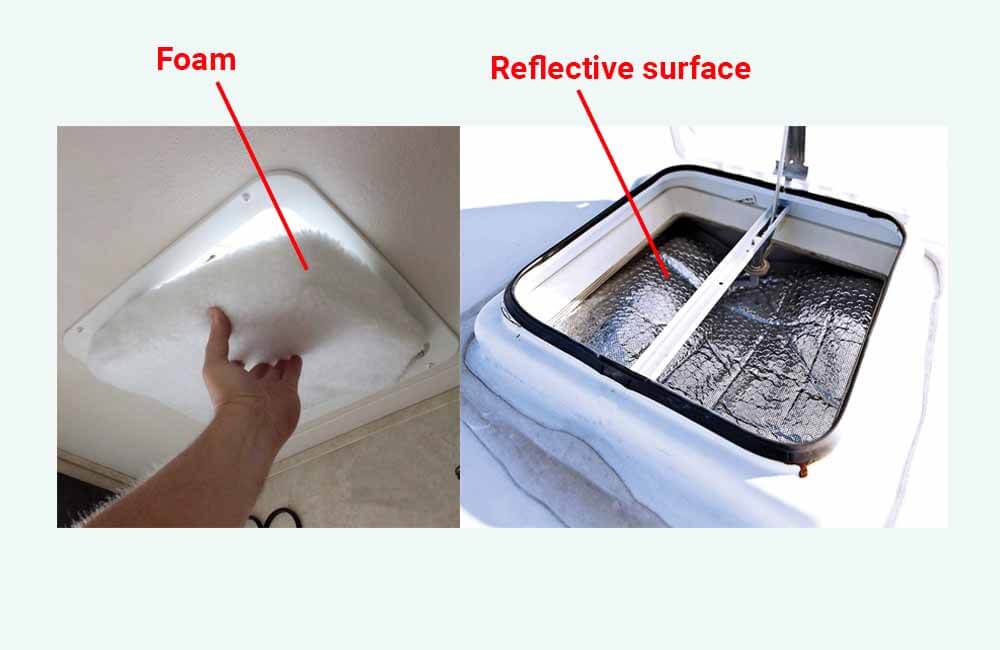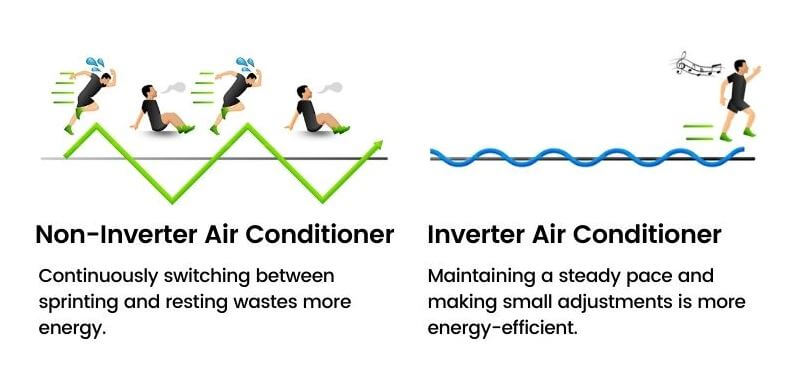Although air conditioners consume A LOT of energy, you can still run them on solar. However, to make this as inexpensive as possible, some optimization will be required.
To put things into perspective, I’ll first explain exactly how big of a system you’ll need, and what you can do to improve the efficiency of your built-in RV AC to be able to run it on a smaller system.
I’ll also discuss an alternative to your existing air conditioner that’ll make it much more realistic to run your whole RV on solar.
How many solar panels do I need to run my RV AC?
The average RV air conditioner is rated at 13500 or 15000 BTUs and consumes 1 to 1.5 kWh of energy per hour of run time. To offset this amount of energy consumption, you would need 200 to 300 Watts of solar power, and that’s just to run the AC for 1 hour.
For example, if you’re in the habit of running your RV air conditioner for 5 hours a day, you would 1000 to 1500 Watts of solar power.
The exact amount of solar power that you’d need mainly depends on the average amount of sunlight that the solar panels would receive, as well as the temperatures that you’ll be dealing with.
Additionally, solar panels alone will not be sufficient. You would need a system that consists of:
- Solar panels
- A solar charge controller
- A battery bank
- An inverter

Each of these components will need to be sized correctly. And the sizes and ratings of these components depend mainly on your location (or locations you’ll be visiting), the average energy consumption of your AC, and the average usage time of the AC.
For example, in this detailed article about how to size a solar system for your RV AC, I gave an example with the following assumptions:
- The air conditioner consumes about 1.2 kWh of energy per hour.
- The air conditioner is left on for 3 hours a day.
- The RV will be parked in Moab, Utah.
With these assumptions in mind, the following are the size of the components necessary to run this AC:
- At least 615 Watts of solar panels.
- 4 Lithium batteries, each rated at 100AH.
- A 30 Amp MPPT solar charge controller.
- A 4000W inverter, or a 2000W inverter with a soft starter.
To learn more about the process involved in these calculations, and the tools that you’ll need, please refer to this article: How much solar power do you need to run RV AC?
As mentioned above, these calculations are based on the assumption that the air conditioner consumes 1.2 kWh per hour. Your RV AC consumes a similar amount of energy, but it doesn’t have to.
With some optimization, you could probably reduce that amount of energy consumption by at least 30%, while maintaining your comfort, or even improving it.
In other words, with a few adjustments to your RV, you could probably reduce the costs of the system by 30% or more. The next sections of this article explain exactly how you can do that.
Tips on reducing the energy consumption of your RV AC
When you turn on your air conditioner and set a temperature, the compressor, which is the main component of your AC, will stay ON until that set temperature is achieved. Once it is achieved, the compressor will turn OFF and ON in a way that maintains it.
Now, compressors are huge power consumers, and there’s just no way around that. However, there are a few things that you can implement in your RV, which won’t cost much, and will reduce the amount of work that your AC has to do to achieve that set temperature.
Therefore increasing the energy efficiency of your RV, and achieving indoor comfort at a lower energy cost.
There is also another alternative to your built-in RV air conditioner, which alone, can have a significant impact on your energy consumption. But first, let’s see what you can do to minimize the energy consumption of your existing RV AC.
Choose the right temperature set-point
The thermostat is a great way to start when trying to reduce the energy consumption of your RV AC. When it’s hot outside, most people set their thermostats to temperatures between 65°F and 70°F, which is unnecessary.
In fact, according to the U.S. Department of Energy, 78°F is the optimal temperature to set your thermostat to. This temperature setting will keep you cool and will prevent the air conditioner from consuming more energy than necessary.
Try different temperature set points (74-78°F) until you’re comfortable, but also make sure to reduce the difference between the set temperature and outdoor temperature as much as possible. The greater the difference, the more energy your AC consumes.
Improve your RV’s thermal insulation
Imagine trying to fill a bucket with water, only the bucket has holes in it. In this analogy, the RV is the bucket, the cool air is the water, and the air conditioner is the faucet.
In a perfect world, in which the RV is perfectly insulated, you’ll only need to fill it with cool air once and it will stay cool. But in the real world, your RV is far from being perfectly insulated.
Your air conditioner will initially work hard to reach the temperature set point, but the RV will exchange heat with the outdoors, which means that the AC will still need to work harder, and therefore consume more energy.
However, with a little bit of optimization, you can reduce that unwanted heat exchange, which will reduce the stress on your air conditioner and the extra energy consumption that comes with it.
So, how do you improve your RV’s insulation?
Basically, you’ll need to seal all the metaphorical holes in your vehicle. The easiest way to start is to insulate the vents and skylights of your RV.
And the easiest way to do that is to use products like Camco’s vent and skylight insulator, which is essentially a cushion with a reflective surface, predesigned to fit in your RV vent and skylight.
The reflective side of the pillow reflects sunlight and the solar heat that comes with it, and the foam reduces heat transfer.

You can also use similar reflective material to insulate the door and windows of your RV. You can either buy reflective material in bulk and design it to fit on your windows, or simply use this predesigned sun shield by Camco.
Also, make sure to look for any indication of peeled or damaged door or window seals. If the seals are indeed damaged, you should also replace them and add caulk to avoid any potential heat leaks.
Another important thing to note is that since your solar panels will be installed on the roof of your RV, it’s not really an option to park in the shade.
Constant sunlight hitting your roof can be a blessing in terms of solar energy production, but not so much in terms of insulation and heat exchange.
So how do you insulate your RV roof?
The solar panels can reflect and absorb a lot of the solar energy that your roof is subject to. However, chances are your roof will not be completely covered in solar panels. The best way to do this is to cover or repaint the roof with a white reflective membrane.
The more reflective your RV roof is, the less solar heat it’ll absorb. Roof coatings such as Liquid Rubber’s roof sealant can help reflect the sunlight and prevent potential leaks on your roof.
After improving the insulation of the RV, the next step is to improve the efficiency of the air conditioner itself.
Improve the airflow of the AC
Your RV air conditioner needs to be able to deliver cold air and suck out the warm air as efficiently as possible. The problem is that ducted RV air conditioners are inherently flawed.
Even if you frequently clean or replace the filters, the built-in ducted AC system in your RV makes it very hard to make use of all the air that’s actually been cooled by the air conditioner.
Luckily, people have noticed this flaw and the solution is already out there.
The solution is called RV Airflow, and the manufacturer claims that it can increase the airflow of your air conditioner by 40% on average. Using an anemometer (wind speed metering device), people have tested this claim and found it to be accurate.
In the following video, you’ll find a detailed explanation of this design flaw, its solution, and how you can make the necessary adjustments to fix it.
All of these adjustments will increase the efficiency of your AC and will decrease its energy consumption for sure.
Once you make some or all of these adjustments, you can use an electricity metering device (such as the Kill-A-Watt meter) to monitor the energy consumption of your air conditioner and calculate the size of the solar setup based on that.
However, if you’re willing to walk the extra mile, there is a way to take that air conditioning efficiency to a whole nother level.
Switching to a ductless and inverter type air conditioner
Each kWh (kiloWatt-hour) of energy consumption in your RV will require around 200 Watts of solar power and 100 Ah (Amp-hours) of lithium battery storage (or 160 Ah of lead-acid battery storage). So each kWh of energy that you reduce, can save you hundreds of dollars in upfront costs.
We’ve discussed temperature settings, insulation, and airflow, but how can you improve the energy efficiency of your RV even further?
The answer is ductless mini-split inverter technology, and here’s why:
1- Mini-split air conditioners are ductless
The built-in air conditioner in your RV puts a lot of energy into making cool air, the problem is, ductwork makes it impossible to use 100% of that cooling capacity.
In fact, according to the U.S. Department of Energy, 25 to 40% of the heating or cooling energy is lost in ductwork.
These losses can be due to air leakage or conduction of heat through the duct wall, or both. In some cases, even with the air conditioner running 100% of the time, these losses can prevent it from reaching the set temperature.
In any case, ductwork is not the most efficient way to deliver cool air.
Mini-split air conditioners, on the other hand, don’t rely on ductwork. The cool or warm air is directly delivered to the room, which results in a higher cooling/heating efficiency.
2- Inverter air conditioners are more efficient
When you turn on your built-in RV air conditioner, it draws around 1300-1600 Watts continuously until the set temperature is achieved. Once the set temperature is achieved, the AC will turn ON and OFF in a way that maintains the temperature.
This results in temperature fluctuations and more energy consumption.
On the other hand, most mini-splits today are equipped with VSD (Variable Speed Drive) technology, which allows their compressors to adjust motor speed based on the temperature.
For example, let’s consider a 12000 BTU Mini-split unit.
When you turn it on, it slowly ramps up to about 900 Watts of power usage until it achieves the set temperature. Once it achieves this set temperature, the compressor operates at a much lower speed and maintains a lower power usage of about 200 to 300 Watts.
This makes inverter air conditioners much more efficient.

Credits
VSD technology also allows mini-splits to run for longer periods with low power usage, which allows them to remove more moisture from the air and increases comfort. As a result, these air conditioners end up performing better, at a lower energy cost.
In fact, according to EnergyStar, inverter-type mini-splits consume – on average – 30% less energy, which is probably a conservative figure.
For example, an experiment was performed in Jeddah, Saudi Arabia, in which two identical and separate rooms were each equipped with a mini-split air conditioner.
These rooms had the same dimensions and were occupied by the same number of people, only one room was equipped with an inverter unit and the other room with a non-inverter unit. The study lasted 108 days and measured the energy consumption of each air conditioner.
The results showed that the inverter air conditioner consumed – on average – 44% less energy than the non-inverter air conditioner (11.6 kWh/day vs 20.8 kWh/day). On one particular day, the inverter unit consumed 60% less energy.
There are many case studies that prove the superior efficiency of inverter mini-splits. So if you’re in the habit of using your RV AC for more than a couple of hours a day, switching to an inverter mini-split can save you hundreds (if not thousands) of dollars in solar panel and battery costs.
Additionally, keep in mind that you’ll have limited roof space to install solar panels. If you’re planning on running everything on solar, you’ll probably NEED to switch to a mini-split. These air conditioners will not only reduce your energy consumption but also free up roof space for more solar panels.
Related: How many solar panels can you fit on your RV?
So, how much energy does an inverter mini-split AC consume?
Although they are more energy-efficient, the energy consumption of these air conditioners still depends on the size and Energy Efficiency Ratio (EER) of the model and other factors such as temperature, insulation, usage time, etc…
However, to give you an idea, the following table estimates the hourly energy consumption of different size inverter mini-split ACs at around 95°F:
| BTU Rating | Est. Hourly Energy Consumption (in kWh) | Est. Hourly Energy Consumption (in Ah @ 12 Volts) |
| 9000 | 0.5 kWh/hour | 40 Ah/hour |
| 12000 | 0.6 kWh/hour | 50 Ah/hour |
| 15000 | 0.80 kWh/hour | 65 Ah/hour |
| 18000 | 1 kWh/hour | 80 Ah/hour |
| 24000 | 1.2 kWh/hour | 100 Ah/hour |
Related: Energy Consumption of a Rooftop RV air conditioner
Click here to learn more about the process of sizing a solar array and the other components needed to run these units.
What size mini-split air conditioner will you need for your RV?
If your RV came with a 13500 or a 15000 BTU rooftop AC unit, your safest bet is a 12000 BTU (1 Ton) mini-split air conditioner, especially if you’ll be staying in areas with extreme temperatures.
You could go with a 9000 BTU unit, however, unless you’ve made insulation upgrades to your RV, 9000 BTU of AC capacity might not be enough.
If you have a bigger vehicle that came with 27000 or 30000 BTUs of air conditioning capacity, you should get two 12000 BTU AC units.
But make sure to get a unit with a high Seasonal Energy Efficiency Ratio (SEER) rating (above 19). The higher the SEER rating, the more efficient the AC unit is.
For example, one of the most popular choices out there is the MrCool mini-split air conditioner. This unit has a high SEER rating of 22, which is not very common.
If you’re curious about how easy it is to install a new air conditioner in your RV, watch this video:

